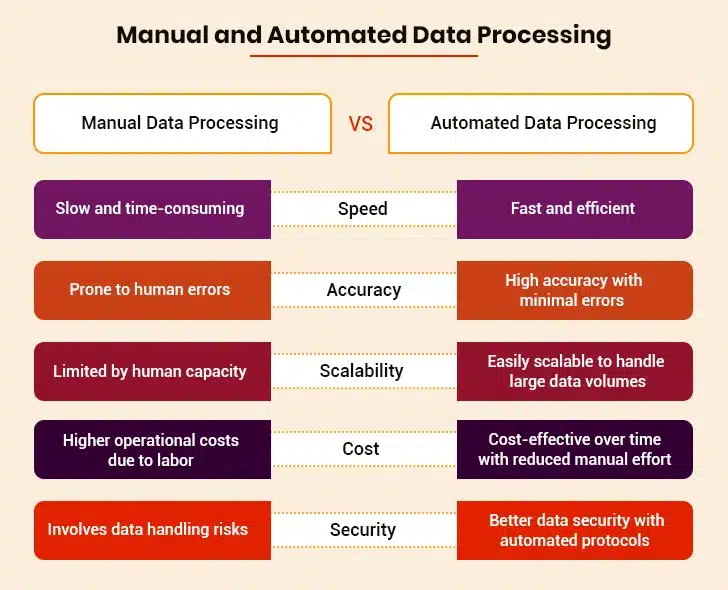Spreadsheets have long been the workhorse of data analysis, offering a familiar and flexible interface for processing raw data and generating insights. From sales figures to customer demographics, countless hours were spent meticulously arranging rows and columns to extract helpful information from the cold expanse of numbers. However, as data volumes skyrocket and analysis demand become more complex, the limitations of spreadsheets become increasingly apparent—relying on this traditional approach is no longer effective in times of information overload.
This is where automated data processing steps in, offering a transformative leap in how businesses process and analyze data. It is a paradigm shift that elevates data analysis from a slow, manual process to a swift, high-powered sprint. By embracing such new-age solutions, companies easily overcome the limitations of spreadsheets and reap a spectrum of benefits, including streamlined efficiency, deeper insights, and game-changing discoveries.
Table of Contents
Breaking Free from Spreadsheet Shackles with Automated Data Processing
The Automated Data Processing Transformation
Real-World Use Cases of Automated Data Processing Across Industries
The Spreadsheet Dilemma
Before automation disrupted businesses, spreadsheets were used for data analysis. These have now become a liability with the weight of ever-growing datasets. They struggle to ensure data integrity, handle complex calculations, and provide timely insights. Their limitations are stark, as listed below:
I. Manual Errors
Spreadsheets are prone to human errors such as typos, formula inconsistencies, data duplication, etc. Such discrepancies generate misleading results, leading to missed opportunities, sub-optimal efficiency, and drained resources.
II. Inflexibility
Scalability is a significant hurdle in the antiquated process of analyzing data via spreadsheets. Adding new data or modifying existing analyses often requires rebuilding the entire spreadsheet, making it a time-consuming and error-prone process.
III. Limited Functionality
Spreadsheets lack the advanced analytical capabilities for sophisticated tasks like statistical modeling, machine learning, complex visualizations, and real-time analysis. This poses a significant challenge for industries where real-time data processing, analysis, and insights are essential, such as healthcare, finance, insurance, and ecommerce.
Breaking Free from Spreadsheet Shackles with Automated Data Processing
Automated data processing uses technology to collect, organize, analyze, and manage data with minimal human intervention. It streamlines repetitive tasks like data entry, validation, and reporting, improving speed and accuracy. Modern data processing tools, systems, and equipment help businesses handle large volumes of data more efficiently, reduce errors, and make faster, data-driven decisions.
Comparison Table: Manual and Automated Data Processing
The Automated Data Processing Transformation
Overcoming the limitations of manual data pooling and processing, automated data processing solutions are a boon for businesses looking to convert raw data into actionable insights in real time and make informed decisions. In addition to this, companies gain other tangible benefits, as listed below:
1. Efficiency Unleashed
Manual data wrangling, a tedious process of cleaning, formatting, and organizing data, consumes a substantial amount of an analyst’s time. Automation takes over these repetitive tasks, freeing analysts to focus on the high-value work of interpretation and insight generation. This translates to faster time to insights, improved operational efficiency, and better decision-making.
2. Data Accuracy Elevated
Human error is inevitable in manual data manipulation, especially when businesses aren’t tech-savvy or lack the resources to pool and process data efficiently. On the contrary, data processing services, powered by automation, minimize these errors, ensuring greater data accuracy and consistency. This is crucial for reliable analysis and avoids skewed results that lead to flawed conclusions and costly misinterpretations.
3. Operational Scalability and Agility Unbound
In the age of data deluge, spreadsheets choke under the weight of large datasets. Automatic data processing companies easily handle vast amounts of data, enabling analysis of complex datasets that were previously too cumbersome to tackle. This paves the way for in-depth and more comprehensive insights once hidden within the data.
4. Data-driven Insights Amplified
Automation goes beyond just processing data. It also employs advanced analytics techniques like Machine Learning and Artificial Intelligence to uncover hidden patterns, anomalies, and correlations that human analysts might miss. This unlocks a new level of understanding, allowing for predictive modeling, trend forecasting, and proactive decision-making.
5. Seamless Integration and Collaboration
Data silos are a common challenge for businesses. Automatic data processing and analysis pipelines and platforms bridge the gaps between disparate systems, facilitating collaboration by providing a centralized and shared repository for data-driven insights. This breaks down data silos and improves transparency by providing a unified view of insights and analysis—enabling teams to work together more effectively towards shared goals.
6. Speed Demystified
Making the right decisions at the right time is the key to success in today’s fast-paced business environment. As a savior, automatic data processing provides real-time insights, enabling business owners to react to market changes and capitalize on opportunities instantaneously.
To better understand the significance of automated data processing solutions, consider, for example, a retail chain leveraging automated data processing to analyze customer purchase patterns. The system reveals an unexpected correlation between rainy weather and increased cozy sweaters and winter wear sales. Using this insight, the retailer can proactively adjust its inventory levels and launch targeted marketing campaigns, maximizing sales and minimizing waste.
In a nutshell, bygone are the days when analysts had to sift through endless charts and graphs, searching for elusive patterns. Businesses can leverage the power of automation and cutting-edge analytics tools that unveil hidden trends, predict future behaviors, and identify previously invisible correlations. From optimizing healthcare resource allocation to pinpointing fraud in financial transactions, automatic data processing solutions empower businesses across every industry to make data-driven decisions that propel them toward success.
Bygone are the days when analysts had to sift through endless charts and graphs, searching for elusive patterns. Businesses can use automation and cutting-edge analytics tools that unveil hidden trends, predict future behaviors, and identify previously invisible correlations. From optimizing healthcare resource allocation to pinpointing fraud in financial transactions, automatic data processing solutions empower businesses across every industry to make data-driven decisions that propel them toward success.
Seamless Operations Begin Here! Harness Our Expertise in Streamlined Data Processing
Real-World Use Cases of Automated Data Processing Across Industries
Here are some prominent automated data processing examples across different industries:
1. Healthcare
2. Retail
3. Manufacturing
4. Finance
5. Logistics
6. Education
7. Ecommerce
8. Agriculture
9. Telecommunications
10. Government Bodies
Skilled Professionals
Outsourcing is a smart way for businesses with limited resources to get professional excellence. They should find data processing specialists who tailor solutions to business-specific needs and industries. All their practices are legally compliant and adhere to the set industry standards.
Cutting-Edge Technology
Enhanced Security
Data integrity is a prime concern for businesses outsourcing their data processing needs. Acknowledging this, the service providers create a secure and compliant environment, ensuring the privacy and integrity of business information. However, achieving the right balance between stringent data security and broader business goals remains a challenge—only 14% of security leaders have been able to do so successfully. This highlights the importance of partnering with a provider that prioritizes security and aligns with your strategic objectives.
Hospitals employ an automated data processing system to handle electronic health records (EHRs). Patient information from laboratories, imaging facilities, and physician visits is gathered, processed, and updated in real time. Automated data processing applications minimize errors and enhance accuracy in diagnosis and treatment planning.
Medical professionals use automated data processing devices such as EHR software and networked devices to automate patient workflows, maintain HIPAA compliance, and provide quicker care. This makes the process more efficient while minimizing administrative burden, especially in busy medical centers.
Retailers use automated data processing technologies to monitor customer actions, purchasing behavior, and tastes. With an effective automated data processing system, companies personalize suggestions, forecast trends, and streamline inventory control. Automated data processing devices such as point-of-sale machines, CRM software, and loyalty applications collect real-time data and channel it to marketing machines. This data-centric strategy allows hyper-personalized promotions, stimulates customer activity, and boosts conversions with minimal human touches.
Manufacturers use automated data processing systems to analyze equipment performance in real time. Sensors in machinery transmit information to centralized systems, which process and analyze it using modern data processing equipment. The system identifies anomalies, predicts breakdowns, and initiates maintenance ahead of time.
Employing automated data processing tools helps companies avoid downtime, lengthen machine longevity, and reduce repair expenses. Predictive maintenance guarantees smoother functioning, increased standards of safety, and improved use of resources in the factory.
Banks and financial institutions outsource data processing to identify suspicious transaction patterns and reduce fraud. Transactional data runs in real time through automated data processing software driven by machine learning technology. These programs alert to deviations or risky activities immediately.
ATMs and card readers are automated data processing tools that input ongoing streams of customer behavior into fraud-detection engines. This leads to quicker response times to threats, more substantial regulatory compliance, and enhanced customer trust.
Logistics and fleet firms employ automated data processing equipment to monitor vehicle locations, fuel utilization, and route planning. IoT devices and GPS sensors are considered automated data processing equipment as they transmit information to centralized boards. An automated data processing software analyzes this information to plan optimal routes, reduce idling time, and avoid fuel theft.
Data management automation helps logistics suppliers deliver on schedule, save money on operations, and enhance driver accountability, all essential components of supply chain success.
Schools use data processing systems to monitor attendance, grades, and behavioral trends. Intelligent devices and learning platforms serve as automated data processing hardware, gathering information from virtual classrooms.
Automated data processing tools process the information to determine students falling behind, recommend interventions, and tailor learning pathways. Automation saves administrative time and enables educators to make informed decisions based on data that enhance student performance and institutional effectiveness.
Ecommerce websites use automated data processing systems to keep track of huge inventories and process orders. Barcode readers and scanners are examples of automated data processing hardware, which refresh stock quantities and shipping status in real time.
Automated data processing software provides end-to-end integration between warehouses, payment processors, and logistics companies. This reduces order mistakes, avoids overselling, and improves the customer experience, particularly during holiday shopping periods such as Black Friday or festive sales.
Contemporary farms utilize sensors, drones, and weather stations as automated processing hardware to keep tabs on soil well-being, moisture content, and crop condition. The information is input into an automated data processing system that directs irrigation, fertilization, and pest management.
Farmers utilize automated processing hardware to forecast yield results and determine when to plant or harvest. This technology-based method maximizes yields, minimizes wastage, and facilitates eco-friendly agricultural practice with minimal manual effort.
Telecom operators use automated data handling systems to track network usage, call drops, and signal quality over areas. Data collected from routers, towers, and user equipment is examined in real time. Automated data handling devices then recommend network optimization or notify engineers of problems prior to their effect on the service. This automation provides high-quality service, quicker problem-solving, and optimized infrastructure deployment according to usage and demand.
Governments use automated data processing machines to process citizen records, benefit disbursement, and tax payment. Automated data processing equipment collects vast amounts of public data, such as biometric scanners, web portals, and kiosks. These are processed through automated data processing machinery to identify fraud, authenticate identity, and facilitate timely service delivery.
All in all, automation increases transparency, minimizes paperwork, and promotes faster service delivery of passports, licenses, or subsidies to citizens.
Data Processing Outsourcing: The Strategic Leap
Implementing automated data processing in-house is a daunting task. Thus, the need for data processing outsourcing services arises. Some of the compelling reasons why organizations, regardless of their size or type, should invest in these:
Data processing companies are equipped with advanced analysis tools and technologies. Thus, organizations easily access advanced data processing tools and platforms to quickly analyze bulk volumes of datasets without the burden of infrastructure investment. Besides, the vendors can alter their data processing approaches as the business grows without incurring additional costs.
Concluding Thoughts
Businesses that still rely on spreadsheets as the sole data analysis tool are missing out on opportunities, while the ones that are embracing the power of automated data processing are unlocking the true potential of their information. Partnering with a reliable data processing management company can help businesses easily embark on a transformative journey toward data-driven success.







